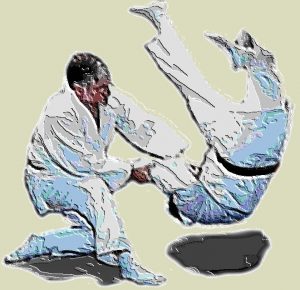As students of Danzan Ryu, you’re learning more than physical skills. You’re studying an art rich in tradition and meaning. While we hope the techniques you learn are never needed outside of class, take the principles of Danzan Ryu with you everywhere you go.
In addition to the information you’ll find here, you should become familiar with the history of Danzan Ryu and Medford Judo Academy, as well as Master Okazaki’s Esoteric Principles (view at ajjf.org).
Attention MJA Students: Here’s where you can find your Student Research Paper questions.
Etiquette
Some basics:
1) When entering or leaving the dojo, bow toward the flag.
2) Never wear your obi (belt which signifies your rank) outside of the dojo.
3) Never wear your gi (uniform) as a costume.
4) When stepping on or off the mat, stand on edge of mat and bow toward the flag.
During class:
1) Always give the sensei (teacher) your full attention and respect.
2) When students are called to attention at the open and close of class, you should be standing at attention, in a straight line (by rank), with your gi tidy.
3) If class is already in session before you step onto the mat, stand on edge of mat and bow toward the flag, then wait for the sensei to bow you into class. Always walk behind the other students to your place.
4) When working with a partner or group, bow together at the beginning and end of your workout.
5) If leaving the mat during class, wait for permission from the sensei. Bow to the sensei and then bow off the mat.
6) When class is closed, remain at attention in line until all senseis are off the mat. Exit the mat by rank.
Bowing and sitting:
1) Rei – standing bow – feet together, palms on front of thighs, bow, sliding hands down thighs until fingers touch the knees. Keep your eyes on the person you’re bowing to.
2) Zarei – kneeling bow – knees together, feet together, soles up, make a triangle with the thumb and forefingers on mat a few inches in front of knees, touch forehead to mat in triangle.
3) Seiza – sitting on knees – kneel and sit back on your ankles.
4) Anza – sitting with legs crossed.
5) Whenever seated during class, sit seiza or anza, with your hands resting on your thighs. Always stand with your right leg first.
Safety
This is a physically demanding art, and there is certainly potential for injury. However, working safely is every student’s and instructor’s responsibility.
Tap: If you are in pain or placed in a dangerous position, tap your partner, yourself or the mat so that your partner is aware that you wish to stop. The tap should be loud and/or solidly felt.
If someone is injured, stop and call an instructor. Instructors have training in first aid and athletic taping.
Be sure the dojo always has your current phone number in case of emergency.
DO NOT practice or demonstrate techniques on others outside the dojo. (Remember: The best self-defense is to never get in a situation that requires self-defense.)




 are reserved for black belt ranks, and the minimum age to attain that level is 16.
are reserved for black belt ranks, and the minimum age to attain that level is 16.